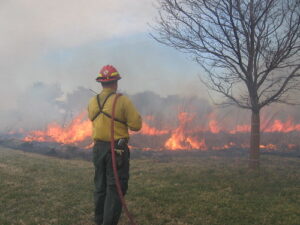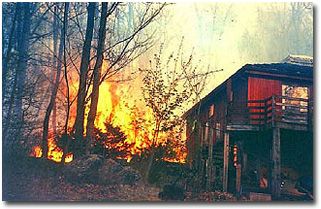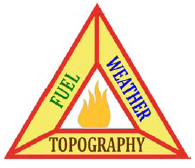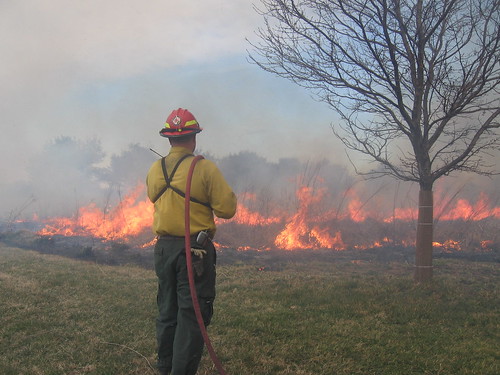 Spring wildfire season has begun in Maryland, and the Maryland Department of Natural Resources (DNR) urges residents across the state to prepare and help prevent wildfires.
Spring wildfire season has begun in Maryland, and the Maryland Department of Natural Resources (DNR) urges residents across the state to prepare and help prevent wildfires.
Wildfire occurrence is highest in the spring and fall when forest fuels are the driest and weather conditions — warm, dry, and windy — are most conducive for the spread of fire. On days when this threat is most likely, the department will issue a “red flag” status.
“We have already seen fire activity this season and urge residents to take precautions and be vigilant,” Maryland Forest Service State Fire Supervisor Chris Robertson said. “Our state and local firefighters are prepared for the season, and we ask the public’s help in preventing dangerous incidents that can threaten lives, property, and natural resources.”
Each year, the Maryland Forest Service responds to an average of 122 wildland fires that burn 1,050 acres of forest, brush, and grasses. DNR also helps equip and train Maryland’s local volunteer fire companies to combat wildland fires through its Volunteer Fire Assistance Program.
The leading cause of wildfires in Maryland is burning of debris or any kind of outdoor burning, which accounts for 30% of fires in the state. Lightning is the only natural source of fire ignition, but accounts for only 6% of fire starts.
The Maryland Forest Service recommends alternatives that are safer and more environmentally friendly than outdoor debris burning — including composting or mulching of yard waste, leaves and brush, and using larger brush or trees for firewood.
Outdoor burning should only be done on low fire danger days. State regulations apply to activities in woodland and within 200 feet of woodland, or activities adjacent to or within an area where flammable materials are located.
Open air burning is only allowed if:
- There is a natural or constructed fire break at least 10 feet wide completely around the material to be burned that is free of flammable materials;
- Adequate personnel and equipment are present to prevent the fire from escaping;
- At least one responsible person remains at the location of the fire until the last spark is out; and
- Burning occurs between the hours of 4 p.m. and midnight unless the ground is covered with snow.
Residents should check with their county or municipal health department for local regulations and permit requirements before burning.
Learn the Facts About Fire Behavior in Maryland
Wildfire Statistics
Wildfires are a common occurrence in Maryland. In an average year, the Maryland Forest Service responds to an average of 123 wildfires that burn more than 1,780 acres of forest, brush, and grasses. Fire departments respond to over 5,000 wildfire incidents per year.
While some wildfires in Maryland can burn hundreds or even thousands of acres, most are smaller in size, burning less than 10 acres. Even these smaller wildfires can threaten lives, homes, other structures, and our natural resources. Each year hundreds of homes and structures are threatened, and dozens are damaged or destroyed by wildfires.
Fire Season
Wildfires occur in every month in Maryland, but peak in the spring and fall. During these seasons the leaves are off the deciduous trees, allowing sunlight and wind to reach the forest floor and dry the forest fuels. The relative humidity of the air is also drier and, combined with a breeze, creates the conditions for wildfires to spread rapidly.
Wildfire Causes

The only natural cause of wildfires is lightning, and this accounts for only 4% of the wildfire ignitions in Maryland. The remaining 96% of wildfires are caused by humans. Maryland’s leading cause of wildfires is improper debris or outdoor burning that ignites an average of 35% of the fires each year. Arson, the second leading cause, accounts for around 30% of ignitions. Other causes include: equipment use, children playing with fire, smoking, campfires, railroads, and other miscellaneous ignitions from sources such as downed power lines, discarded ashes, and fireworks.
The Wildland-Urban Interface
A wildfire is an even greater challenge when it threatens homes and other structures. The zone where homes are built in or near the forest is called the Wildland-Urban Interface (WUI). The number of homes built in the WUI in Maryland has increased dramatically in recent years.
Since 96% of wildfires are caused by people, wildfire ignitions are also more common in these Wildland-Urban Interface zones. Considering all factors, wildfires can be a significant threat in Maryland. Homes and other structures intermixed with wildland fuels are at risk, and WUI residents need to take actions to protect themselves and their property.
Fire Behavior
Most wildfires in Maryland are surface fires, which burn fallen leaves, twigs, and debris on the ground. Under this fallen debris is often a layer of partially decomposed leaves and humus, called “duff.” During dry periods, fires can burn underground in this duff layer, and be very difficult to extinguish. These duff fires can burn for weeks, or even months, and cause smoke issues.
The intensity of wildfires increases greatly in areas of dense fine fuels, such as grasses, or dense resinous fuels, such as mountain laurel shrubs or evergreen trees.

In these areas, wildfires can spread rapidly and burn with amazing intensity. Maryland rarely experiences active crown fires – wildfires that burn in the tree canopy. However, crown fires can occur in dense stands of evergreen trees during times of very dry and windy weather.
The Wildfire Behavior Triangle
The three factors that control wildfire behavior are fuels, weather, and topography. In all fuel types the intensity and rate-of-spread of a fire will increase as slope increases, wind increases, and relative humidity decreases.
Prescribed Fire
Prescribed fires, or fires ignited under controlled conditions by fire professionals, can be beneficial to reduce forest fuels, improve wildlife habitat, and prepare sites for tree planting.



